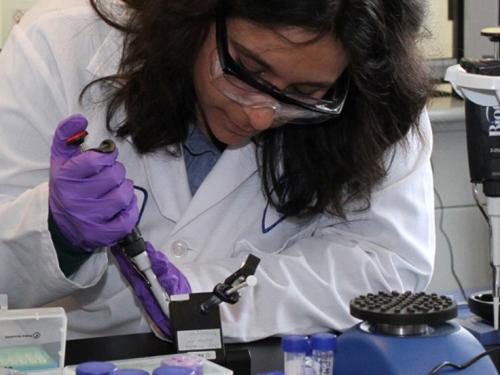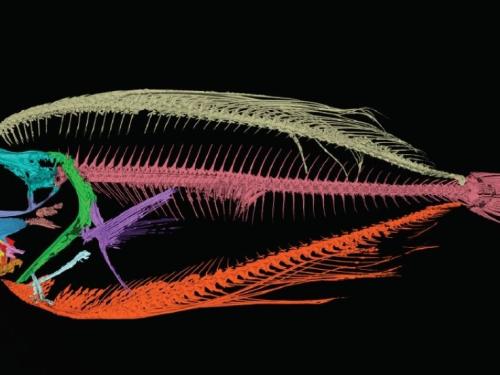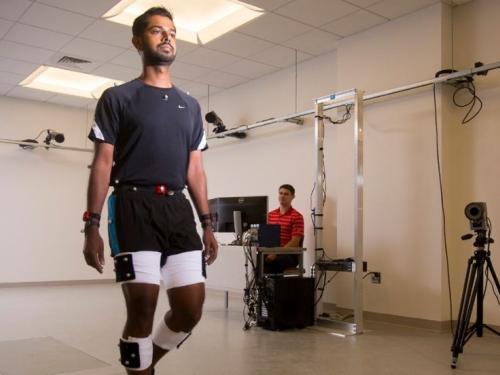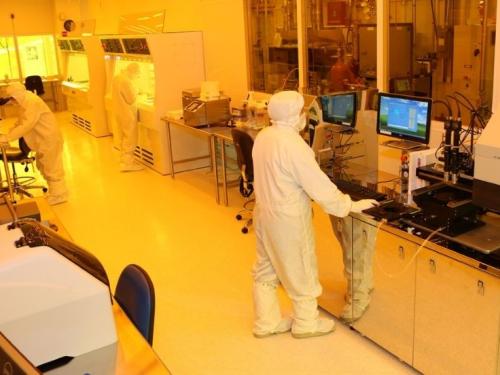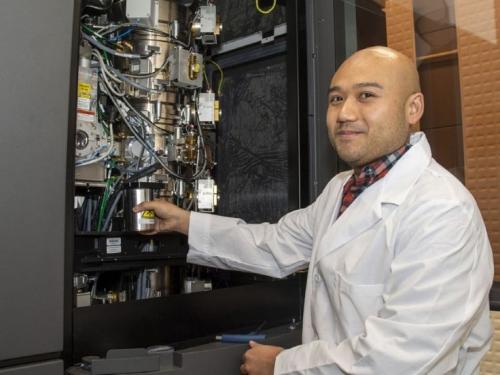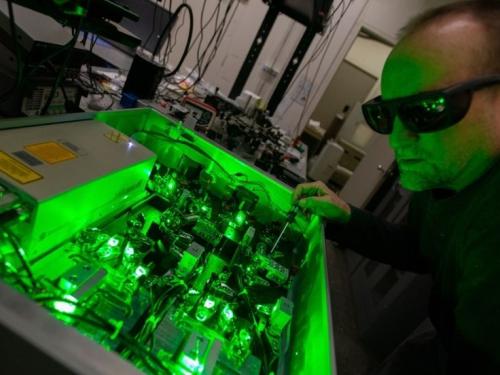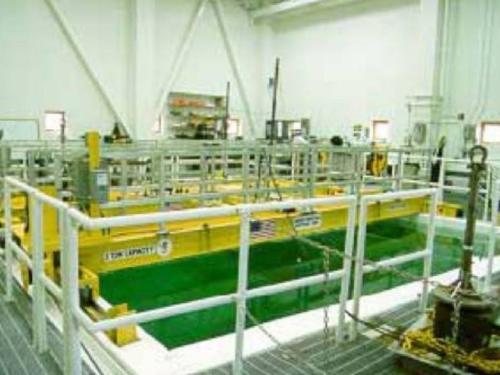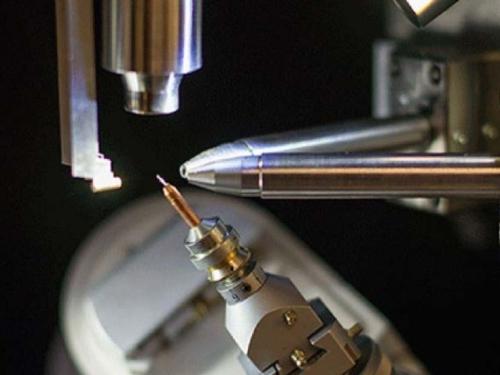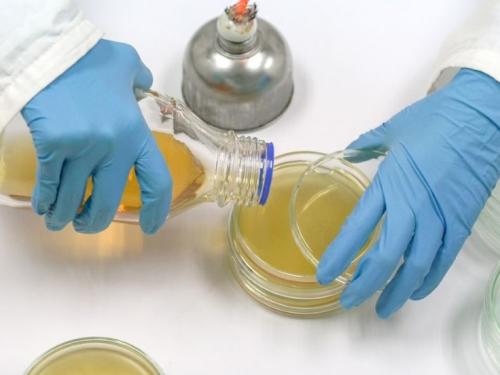Provides expert engineering support and consultation to transform your imagination and ideas into functional 3D models with the use of additive manufacturing and laser cutting. Printing technologies include FFF and SLA with a wide variety of polymers including flexible, rigid, and high strength.
Core Facilities Capabilities
The capabilities available at each facility are as unique as the researchers found at each location.
Our expertise ranges from life sciences to material sciences, nanofabrication to biomanufacturing, robotics to mechanical prototyping, chemistry to high-performance computing, and more. The listing below is in alphabetical order.
A-D
Providing large quantities of high-quality recombinant adeno-associated virus for gene therapy research. The technology and processes are developed to be “GMP transferable” to facilitate the transition from bench to bedside.
The lab offers training, testing, and standards development in the areas of additive fabrication, cold spray, and others. Available equipment includes Instron 3367, Danatronics Echo 9 galvanic corrosion tester, salt spray corrosion tester, Identron impact tester, Fischer poroscope, Falex wear tester, Zeiss Axioscope.
Cutting-edge 3D printing in metals and polymers for fabrication, research, training, and education. Printing technologies include DMLS, DED, SLS, FFF and PolyJet.
Rapid prototyping in a variety of materials with several types of 3D printing and CNC milling machines. Major equipment includes GCC LaserPro Spirit LS; Objet30; Roland MDX-540SA; Markforged Mark 2; and Roland MDX-40A; and Formlabs Form 2.
Includes a Philip’s Ingenia CX dStream 3.0T system, and RF coil labs supporting MRI imaging for humans and large or small animals.
Offers a wide-variety of analytical chemistry services, instruments, and technical expertise including GPC, HPLC, LC/MS, Surface Plasmon Resonance (SPR). The ACL provides quantitative and qualitative analysis, purity testing, and method development.
Designed to assist members of the research community on UMass and other five college campuses to conduct research using live animal imaging technologies. Equipment is capable of fluorescence and luminescence imaging independent of or concurrent with CT imaging.
The Small Animal Imaging lab (SAI) provides live, small animal imaging services utilizing a Bruker MRI, Mediso PET/CT and SPECT/CT, and IVIS Spectrum.
Provides transgenic, gene targeting, and mouse surgery service and training, performs microinjections of DNA into fertilized embryos to generate transgenic mice. Uses cutting-edge technologies, CRISPR/Cas9 genome editing, to generate gene knock-out or knock-in mice or other animal models.
Houses mice, rats, axolotl and zebrafish; purchases animals; trains researchers regarding proper animal care and use; monitors the safety of all personnel with laboratory animal contact; and provides technical and veterinary services and mouse breeding management. Includes a Barrier Suite and Perkin Elmer IVIS Lumina XRMS Series III.
Provides analytical and high resolution scanning probed based microscopy. This includes Atomic Force Microscopy (AFM) related techniques such as tapping mode, contact mode or conductive AFM as well as force measurements.
Facility evaluates, selects, and implements when needed the best of breed computational solutions for the analysis of biological data. This allows those who generate the data to be able to analyze it using state-of-the-art methods by reducing the computational expertise required to apply these methods.
Interactions between biological macromolecules like proteins, nucleic acids, lipids and their complexes, and small molecule interactions with these macromolecules.
Equipment for expression, separation, and isolation of biomolecules allowing users to culture cells including bacterial, yeast, insect, plant, and mammalian cells, and then separate biomolecules of interest ie. proteins, nucleic acids, natural products, and metabolites.
Bone imaging services, bone histology and histomorphometry services utilizing a microCT35 Scanco camera.
Spectral assessment of a wide variety of biological materials ranging from tissues to complex mixtures in the very far IR, near IR, visible and UV spectral ranges featuring a SENTERRA II confocal raman microscope.
Two cell culture facilities for both biological and bioengineering approaches. Biosafety cabinets, incubators and general wet lab supplies.
- Exercise Intervention and Outcomes:
Diagnostic testing capabilities include exercise performance, VO2 max, exercise stress testing, strength testing, body composition (including abdominal obesity) and bone density evaluation. - Human Motion:
Assessment of human movement (free-living and robot-assisted) and human and robotic testing of sensor technologies. - Living Science:
Evaluate biosensor performance in healthy participants or participants who are at risk for chronic disease while living in a natural environment. - Room Calorimeter:
Capability to measure 24-hour human energy expenditure for purposes of movement sensor calibration and validation, and to conduct studies requiring assessment of energy balance and energy metabolism. - Sleep Monitoring:
Lab Equipped with partial and whole-head EEG systems for recording sleep physiology (sleep staging). A central control room will allow for on-line observation of sleep and monitoring of sleep in populations from infants to the elderly.
Offers massively parallel sequencing with the HiSeq 2500 and MiSeq platforms, next-generation sequencing library preparation from RNA and DNA, single-cell sequencing on the 10X Chromium platform; and nucleic acid quality assessments using Bioanalyzer, Tapestation, Nanodrop and Qubit assays. Additional instruments include a Nanostring nCounter Analysis System, and a QuantStudio 12K Flex Real-Time PCR.
A full-scale academic survey research center that conducts basic and applied research contributing to knowledge and understanding of important social issues. CSR maintains a professional interviewing staff, computer-assisted telephone facilities and survey sampling capacity, as well as the ability to conduct mail- and web-based surveys.
CRC is dedicated to efficient, reliable and high-quality study support for UMass clinical investigators to utilize the services as needed such as exams rooms for study visits, laboratory equipment and experienced staff to assist with clinical trial and research support services. Also offered is assistance with budget, contracts and regulatory expertise to support the management and conduct of clinical research.
Provides consultative and collaborative service in computational and molecular modeling.
Conquering Diseases is an easy-to-use web-based search tool to find, share and save clinical studies relevant to patients. It also provides educational resources to help patients and families learn about and find clinical studies.
Provides instrumentation for the determination of crystal structures using X-Ray diffraction techniques.
Provides services such as compliant access to data, data innovation research, and spearheading data collaborations.
2nd Largest sequencing facility in the Northeast offering next-generation MPSS sequencing for whole-genome analysis, Chip-SEQ, small RNA profiling & gene expression applications with Illumina Genome Analyzer
A full suite of mechanical testing capabilities, including tension, compression and torsion fatigue testing, surface roughness measurement, 3D scanning, and surface hardness measurement.
Designed to have CMOS processing technologies to serve as a key enabler towards personalized healthcare and preemptive medicine. Specifically, we aim to develop smart and miniature devices, circuits and systems with biomedical applications such as biosensing, DNA sequencing and smart implanting.
Supplies required for Drosophila research.
E-H
Provides services, technical expertise, scanning and transmission electron microscopes and ancillary equipment for the characterization of nano-engineered materials, microelectronics, photonics, biomaterials, and others in life sciences, drug discovery, environmental and energy applications. Instruments include JEOL SEM, Zeiss Fib-SEM, TEM, Confocal Laser Scanning, LSCM, AFM, and Stereo microscopes.
Transmission (TEM) and Scanning (SEM) Electron Microscopes as well as related sample preparation equipment.
Scanning (SEM) and Field Emission (FESEM) Scanning Electron Microscopes and technical expertise for the characterization of nano-engineered materials, microelectronics, and others.
Scanning & Transmission electron microscopes coupled with ancillary equipment required for key ultra- structural procedures from the tissue to the molecular level.
Offers a range of state-of-the-art analytical instruments for the characterization of optical, electronic, electrical, and electrochemical properties of materials as well as tools for solvent-based fabrication and characterization of such optoelectronic devices as solar cells, light-emitting diodes, and field-effect transistors in the inert atmosphere of glove boxes.
Analytical instrumentation and sample processing featuring IRMS, GC-MS, ICP-MS, SEM, FTIR, UV-Vis, and ED-XRF.
Dedicated space for design, prototyping, pilot manufacturing and testing of high-tech fabrics, flexible electronics and medical textiles. Available equipment includes roll-to-roll processing, 3D printing, multi-component fiber extrusion lines, textile assembly (knitting, weaving, braiding), and textile finishing including coating, printing, sewing and bonding. A wide range of mechanical, thermal, flammability, and durability testing equipment and services are also available.
Provides the latest technologies in flow cytometry to the area research community. Fluorescence-based flow cytometric analysis and microscope-based high-throughput imaging instrumentation is available. Analysis equipment is accessible to trained users 24/7 and fluorescence assisted cell sorting is offered by appointment. Instrument training, experimental design, scientific consultation and sample processing are also offered.
Rapid, cost-effective high throughput gene expression, complete miRNA and proteomic analyses by using gold standard RT-qPCR with the combination of custom Integrated Fluidic Circuit technology from Fluidigm.
Provides next-generation DNA sequencing services, NGS library preparation, DNA and RNA quality assessment, DNA and RNA isolation, qPCR, single-cell sequencing on C1 single-cell auto prep system.
Provides world-class measurement capability for frequencies into the Terahertz range. It will be used for high-frequency spectral analysis of materials and for testing high-speed communications technologies.
Provide high throughput/rapid gene expression and complete miRNA profiling analysis by using gold standard qRT-PCR with the custom Integrated Fluidic Circuit technology from Fluidigm.
Brain and whole-body structural and functional imaging and spectroscopy for academic and industry-based research.
Immunodeficient mice that can be engrafted with human cells/tissues for analysis of function.
I-N
iPAC provides image analysis tools and expertise for pre-clinical and clinical imaging studies of different types of diseases from different instruments.
High-resolution 3D imaging of biological specimens using Zeiss LSM 880 confocal laser scanning microscope as well as upright and inverted fluorescence microscopes.
High-quality pharmaceutical services and supports research activities for all clinical trials at UMMS.
The Zeiss LSM 710 confocal microscope system can collect transmitted light images (bright field and DIC) as well as conventional and confocal fluorescence images. Four lasers are available covering the 405 nm to 633 nm range.
Nikon Center of Excellence provides instruments that enable a broad range of light microscopy methods and applications.
State-of-the-art, non-GMP, pilot scale, manufacturing facility for the R&D of biopharmaceutical products requiring a lyophilization process step. The LyoBay pilot-scale facility can assist researchers in bringing laboratory-scale materials to a highly optimized, non-GMP pilot-scale utilizing cutting-edge lyophilization equipment and technology (SP Scientific LyoConstellation S20) in a Class 100 cleanroom.
Analytical mass spectrometry equipment, providing analytical services and expertise in mass spectrometry.
The Environmental Analytical facility provides IRMS, GC-MS and ICP-MS. The Proteomics facility provides LC-MS as well as access to NMR, UV-Vis, FT-IR and AFM.
State of the art proteomics, metabolomics & mass spectrometry imaging analyses. Analysis platforms include 4 Orbitraps (ESI), 2 QQQ (ESI), 1 Q-TOF (ESI, MALDI, DESI), 1 LTQ (ESI) and 1 TOF-TOF (MALDI)
Titan Krios & Talos Arctica, Vitrobot, Gatan K3, cameras, Phase plate solution & tomography software
Offers a wider range of instruments and technical expertise for the characterization of materials including optical profilometry, dynamic light scattering (DLS), and trace analysis using ICP-OES and ICP-MS (atomic mass spectrometry). Applications include nano-engineered materials, microelectronics, photonics, biomaterials, and others with applications in life sciences, drug discovery, environmental and energy research.
Liquid and plate form custom media and laboratory buffers using standard or customer-modified recipes.
Develops algorithms and processes for large-scale wearable sensor networks to support the development of novel hardware.
DNA fragment analysis, Genotyping & SPR services. Host to the Oligonucleotide program providing discounted oligos.
Histology services including routine histologic preparations, special stains, immunohistochemistry & frozen sections.
Facilities, equipment, and training necessary to characterize behavior in wild-type and genetically modified mice.
Targeting genome alterations in human cells & model organisms.
State-of-the-art, 4,200 ft2 Class 100 cleanroom equipped with over 40 pieces of process and analytical instrumentation for complex research projects that require micro and nanoscale fabrication. Technical expertise, foundry services, and use of equipment is available for dicing, stress measurements, deposition, deep silicon etch and photolithography.
Supporting research in microelectronics, electronic materials, nanotechnology, MEMS, biomedical and optical devices. Our staff provides professional suggestions and ideas to lab users on their projects, including planning, design, and integration for fabricating devices. Features Class 100 Cleanroom.
Device design, fabrication process formulation, photomask layout advice, and prototype testing utilizing traditional and novel approaches to microfabrication and nanofabrication of electronic devices, sensors, microfluidic devices, and nanomaterials test structures.
NIH-funded Center as one of five centers in the US to make up the National MMPC Consortium that specializes in sophisticated physiological procedures and instruments to characterize mouse models of obesity, diabetes, and its complications.
The Center consists of the following five phenotyping Cores:
- Metabolism Core uses in vivo metabolic procedures and instruments to assess energy balance, insulin sensitivity and glucose metabolism, and conducts drug trial studies.
- Analytical Core uses high throughput instruments to measure serum and tissue levels of metabolites, hormones, and cytokines.
- Islet Core uses in vivo and in vitro procedures to measure pancreatic function and insulin secretion.
- Cardiovascular Core uses in vivo imaging system to assess cardiac structure and function, and vascular phenotypes.
- Microbiome Core uses fecal collection and antibiotic treatment for gut microbiome analysis.
Neuroradiology facility that offers the latest technology in image-guided intervention in developing minimally invasive treatments.
Interdisciplinary robotics testing, research, and training facility that evaluates robotic capabilities, human performance, and human-robot interaction. Additional resources include Motek M-Gait instrumented treadmill with motion capture (Qualisys and Motion Analysis), a variety of biometric sensors, and NIRx functional near-IR spectroscopy.
Provides Next-Generation DNA & RNA sequencing services and technical expertise including NGS library prep, DNA and RNA quality assessment, Fluorometric quantification of DNA/RNA/Protein, DNA & RNA isolation, PCR/qPCR, Qubit fluorometry, gene expression & drug development studies.
The facility provides high field NMR instruments and expertise to elucidate molecular structure, conformation, dynamics and interactions.
A new, state-of-the-art JEOL 400 MHz NMR equipped with autosampler and automatic tuning & matching. The instrument can perform temperature and kinetic studies as well as x-nuclei and 2D experiments. Self-use and service work are available.
Isolates bioactives by supercritical CO2, concentrate bioactives by reverse osmosis, thermally treat by ultrahigh pasteurization and agitating retort, produce emulsion systems by homogenization and encapsulate by freeze or spray drying.
O-R
Optical Xenogen IVIS 100 imager & Spectrum CT Imager for in vivo detection and quantification of cells.
Northeast hub for PacBio work utilizing PacBio Sequel. Services include sample quality control and assessment, SMRTBell library construction and validation (genomic, amplicon, RNA, targeted) , sequence analysis using 8M SMRTCells, and a variety of data analysis services (including ROI/CCS analysis, Iso-Seq analysis, HGAP assembly, DNA modification and motif detection, and custom applications).
Offers a full range of proteomic services using an Orbitrap Fusion Lumos Tribrid MS including sample preparation, bottom-up protein identification, quantification of expression levels using both label-free and TMT multiplexing strategies, PTM analysis, 2D fractionation, and top-down proteomic analysis.
Clinical and basic research support in biostatistics, experimental design, data analysis, and data management.
Provides controlled radiation environments and analytical measurement services and facilities for proton, neutron and gamma environments.
State-of-the-art single photon computerized tomography (SPECT), positron emission computerized tomography (PET) & X-Ray computerized tomography (CT) cameras for imaging small animals.
Distribution of clones from both the Open Biosystems human & mouse shRNA lentiviral libraries and the Mammalian Gene Collection cDNA library.
Provides a unique set of custom, moving web-based tools for the translation of advanced materials and nanomanufacturing processes to industrially relevant scalable platforms for the development of next generation life science innovations.
S-X
The Hitachi SU-5000 field emission SEM is a microscope used to observe micron/nano-scale structures (resolution of 0.5 nanometer (10-9 m)). The FESEM is equipped with a deceleration mode for improved imaging and avoiding the effects of charging. The SEM is equipped with a secondary electron detector, backscatter detector and an additional STEM detector.
Advanced quantitative light microscopy including super-resolution (SIM/ PALM), multi-photon, TIRF, confocal, and live-cell imaging.
Micro assembly, prototyping, and integration for RF, wire bonding, optics, PCB and wafer/die attach applications.
Support for conducting basic and translational research on mouse and human skin including acquisition of human skin, skin fluid, or skin cells for translational assays such as flow cytometry, ELISA, or single cell RNA sequencing.
Develop high-throughput screens to discover novel drugs & chemical probes utilizing in house 1M compound collection & detection technologies.
90,000 – gallon acoustic – optic test tank designed for development and testing of underwater measurement concepts and devices.
2,200 square foot lab allows scientists to conduct research on living marine and estuarine organisms under controlled conditions.
Structural characterizations, including molecular modeling, small molecule docking and inhibitor design (using the Schrodinger structure based drug design suite), crystallographic studies, organic synthesis and characterization, structure activity relationship (SAR) and chemistry support.
A complete thermal analysis suite including Discovery TGA, Discovery DSC, Q800 DMA, and Instron 4466. Service level work and technical expertise are also provided.
Open access biorepository provides a dynamic collection, storage and distribution service for human samples.
State-of-the-art dual-source Bruker D8 Venture single-crystal diffraction system. Services include crystallization, data collection and structure determination.
Instruments dedicated to the structural analysis of crystalline materials, the determination of highly periodic morphologies in self-assembled systems over a large length scale range.
